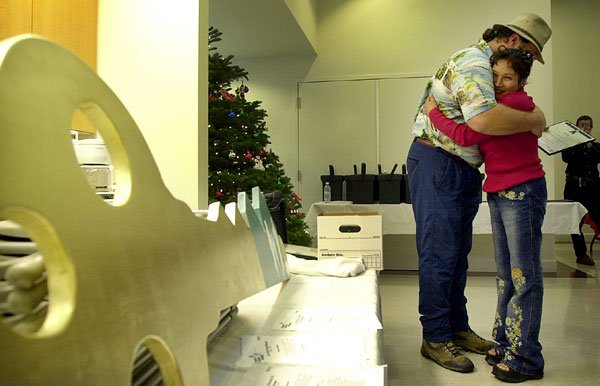
GILROY
– Raquel Mendez, her husband Roberto Avila and their 2-year-old
daughter Gabriella received an early Christmas present Friday – the
keys to a brand-new home in the Gilroy’s Los Arroyos community
subdivision.
GILROY – Raquel Mendez, her husband Roberto Avila and their 2-year-old daughter Gabriella received an early Christmas present Friday – the keys to a brand-new home in the Gilroy’s Los Arroyos community subdivision.
For the past year, Mendez and Avila and 10 other low-income Latino families put in at least 40 hours of work every week as “sweat equity” to build their American dreams in the affordable housing project run by South County Housing. The fruit of their labor arrived at a special ceremony Friday afternoon when Gilroy Mayor Tom Springer presented each family with keys to their new homes. The houses range in floor-space from 1,320-square feet to 1,416-square feet.
The 62-acre, 373-unit Los Arroyos subdivision is located in the northwest section of Gilroy along Monticelli Avenue just off Santa Teresa Boulevard. Begun in 1999, it houses disabled, low-income and senior citizen residents in affordable homes and apartment units. The subdivision also includes a city park, a community recreation hall, and a children’s center with a Go Kids Day Care Center.
Mendez, 22, a part-time teacher and a student at the University California at Monterey Bay, described the road to getting her new home as a difficult one but well-worth traveling.
“It’s hard work. It does take your energy away from you,” said Mendez, describing the hard work put in on weekends building the homes. “But at the end, it’s worth it.”
With financing help from South County Housing, Mendez and Avila will pay $1,085 a month on mortgage payments for a $385,000 home loan. Previously, the family had been living with her parents. Mendez said she’s still not used to the fact she’ll be spending Christmas in a new home. A year ago, her mom had suggested she apply for the special program to help low-income residents obtain affordable housing.
Her application was chosen number four in a lottery of 100 people for their order in processing. After showing bank representatives income tax documents to demonstrate her family qualified for financial assistance, it took about a month for their loan to get approved.
“We were very fortunate,” she said. “Some people have waited for years.”
Friday, the 11 families gathered at the Los Arroyos Senior Center for the special “key exchange” ceremony. Following the ceremony, they celebrated a Catholic mass to bless the homes. The priest scampered from house to house, dodging raindrops as he sprinkled holy water on each entrance door as residents made the sign of the cross.
Dennis Lalor, executive director of South County Housing, praised the families for their endurance and patience in building their homes. He said the families came to know each other well in the last year as they worked on construction chores such as laying cement foundations, building the frame, sheet-rocking, painting and landscaping.
“The end product here is not just the bricks and sticks,” he said. “The end product is creating a neighborhood.”
Although the families take on the responsibility of paying for their mortgages and maintaining their homes, South County Housing will continue to assist them by providing guidance and advice, he said.
“That’s a key to the long-term success of Los Arroyos as a community,” he said. “We will stay involved.”
Funding for the Los Arroyos community comes from state and federal programs as well as local banks such as South Valley National Bank, he said.
During the key exchange ceremony, Lalor pointed at the rain and told the families, “The rainy weather signifies to me that wet weather and adverse conditions have not had a negative effect (on you), and I’m proud of you for that,” he said.
Mayor Springer also congratulated the families on their perseverance in building their homes.
“I want to say, personally, how very, very happy I am that all of you finally realized the American Dream,” he said. “It took a lot of patience and a lot of hard work. You have done more than most people have ever done in your lives. You have built a neighborhood not just of wood, not just of bricks, not just of glass but a human-oriented community of the heart.”
Los Arroyos is a successful model of community planning that provides a safe and pleasant place for people to live, he said, and he hopes Gilroy will continue to provide more such homes for low-income families.
State Assemblyman Simon Salinas, who also was at the ceremony, agreed that affordable housing is a necessity for low-income families to continue living in the expensive Bay Area.
“This is the way it should be done. This is the way a community should be built,” he said. “You’re not just building houses here. You’re building homes. And those homes will stabilize the community of Gilroy.”
Steve Brusa, the “self-help superintendent” who supervised the families in construction techniques, said the self-help-built homes were of the same or better design and construction quality as the commercially-constructed homes on the street.
“You can’t tell the difference,” he said, pointing at the various houses. “I would stack mine up against the contract-built ones any day for quality.”
Although the families learned construction techniques during the year the homes were made, they spent extra time making sure the work was done right because they knew they would live in these houses, he said.
During weekends working on the homes’ construction, the low-income families came to know each other well because they spent so much time together, Brusa said. So, moving in this month, they already have a neighborhood support structure, something the commercially-built home owners do not automatically get when they move into a neighborhood, he said.
“You go down the street, those people don’t know their neighbors because they bought their homes sight unseen,” he said. “Here (where the self-help homes are), the neighbors watch out for each other.”
Evangelina Gonzalez beamed with pride as she showed off her new two-story home. Gonzalez, her husband and four children had previously lived in a cramped Gilroy apartment. She said building her home was hard work but an accomplishment she would treasure.
“This is a new life,” she said. “It’s, for me, a dream come true.”
She showed off her home’s spacious kitchen and the adjoining living room which was empty of furniture. She said she was particularly happy with the fact she now had her own washing machine and clothes dryer in the garage, describing how she no longer had to haul the weekly wash to the Laundromat where she spent about $100 every month in cleaning costs.
“For me, it’s muy bonita, a very beautiful house,” she said. “The street is very quiet, very comfortable.”
Gonzalez said that with financial assistance obtained through South County Housing, her family will pay about $1,300 a month on the mortgage for the four-bedroom home. And she likes the fact she knows the 10 other families now moving into the neighborhood because they can watch out for each other’s children.
“I love these families,” she said. “Each family has a love for each other.”
Her young daughter, Jeannine Gonzalez, also likes her new home.
“It’s very big, and it’s wonderful,” “she said. “There’s bigger space. There’s a garage you can play in when it’s raining.”
For more information on South County Housing, visit the Web site www.ruralisc.org/sch.htm or call 842-9181.












